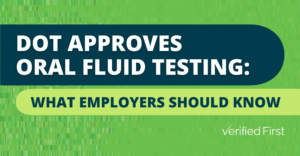
Drug screening compliance continues to change every day. Just last month, the United States Department of Transportation (DOT) published its final rule amending its drug screening regulations to allow for oral fluid testing.
Even though this new rule is in effect (as of June 1, 2023), employers must wait to implement oral swab and fluid testing until The Department of Health and Human Services (HHS) has certified at least two laboratories with the capability to process the tests. It’s likely that the DOT will not start choosing labs until early 2024, meaning it may be some time until these tests are available for DOT use.
As we continue to monitor this situation, it's important to know what these changes will mean for employers. Let’s explore what oral fluid testing is and how these changes impact business and HR leaders like you.
Oral fluid testing is one kind of drug test that uses a person’s saliva to test for controlled substances. These tests offer different benefits and advantages than your typical urine or hair follicle-based test, including:
These benefits make oral fluid testing very enticing to employers screening large quantities of candidates, but there are some disadvantages to keep in mind as well. For example, oral swab testing has a smaller detection window since the presence of drugs does not remain in oral fluids as long as urine and hair follicles. Since oral fluid is a newer test, there are fewer facilities with the capabilities to perform them, and they have not been subjected to the same legal scrutiny as other tests.
It’s important to keep in mind both the advantages and disadvantages of oral fluid testing. While it may be easier and less expensive, it might not be right for every organization.
This new rule gives employers the option to choose which drug test will be used for all its DOT-related screening, including:
Employers can choose different tests for different situations and should consider creating standard orders explaining what kind of tests should be used when. For example, you could opt to use urine testing for random drug tests and oral swab testing for post-accident. Consider what aligns best with your organization and work with your screening provider or collection site to create these operating procedures. If you do choose to use oral fluid testing and change your current processes, it is recommended to also update your current DOT drug testing policies to reflect your new tests and procedures.
While oral swab testing is not yet available for DOT use, and it may be some time before facilities are officially approved, it is smart to understand what these changes mean for your company and how you will respond.
In an industry with strict standards, high turnover, and (often) a shortage of drivers, it’s critical to both hire and maintain safe drivers. Carriers need an experienced DOT screening partner that can quickly and thoroughly vet candidates while solving common pain points such as inconsistent pricing, turnaround times, and a lack of centralized reporting.
Verified First consolidates all of your pre-employment and recurrent screenings under one roof. With our secure online portal, you gain access to MIS reports upon request, electronic chain of custody forms, with customizable DOT screening packages including: